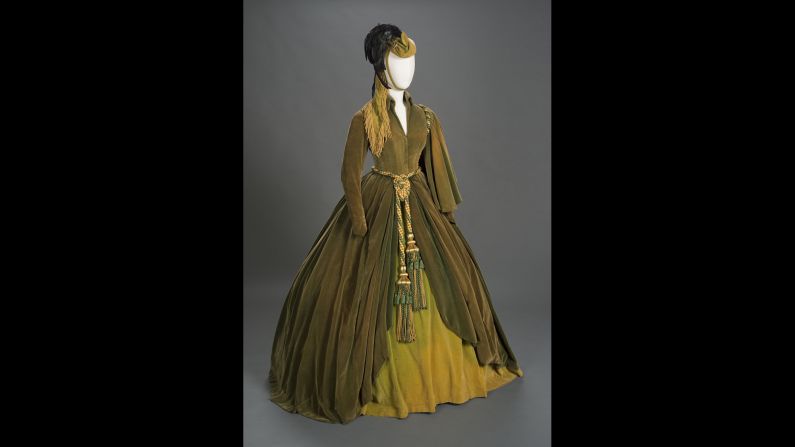
The back story of a complicated classic —
Scarlett O'Hara's green curtain dress -- perhaps the most famous costume in Hollywood history -- is among three original outfits appearing in an exhibition marking the 75th anniversary of the 1939 movie classic "Gone With the Wind." The exhibit opened in September at the Harry Ransom Center at the University of Texas at Austin, detailing the three-plus years it took to bring Margaret Mitchell's best-selling novel to the screen. It runs through January 4.

The back story of a complicated classic —
In an iconic scene from the movie, Scarlett (Vivien Leigh) yanks down her mother's curtains for Mammy (Hattie McDaniel) to make a fancy dress to impress Rhett Butler and try to persuade him to give her $300 to pay the taxes on her plantation. "The curtain dress has a special place in everyone's hearts," says Jill Morena, the Ransom Center's assistant curator for costumes and personal effects.

The back story of a complicated classic —
Scarlett's burgundy ball gown, another original costume on display, is an example of producer David O. Selznick's push for "show-stopping glamour," curator Morena says. "It's really visually compelling on-screen in a tense moment," she says of the shocking outfit Scarlett wears to Ashley's birthday party. "Vivien Leigh just looks stunning in the dress."

The back story of a complicated classic —
Hattie McDaniel received the best supporting actress Oscar for her role as Mammy, becoming the first African-American to win an Academy Award. "She brought something to the performance that really stood out," says Steve Wilson, the exhibition curator. However, segregation in the South prevented the actress from attending the movie's December 1939 premiere in Atlanta with other celebrities.

The back story of a complicated classic —
An October 1936 letter from a Brooklyn, New York, man urged Selznick not to make "a Negro-baiting film" that would encourage groups such as the Ku Klux Klan. The depiction of African-Americans and treatment of Reconstruction in the novel made the film production controversial from the beginning. Selznick wanted to remain faithful to the book, but he dropped the N-word from the movie's script as well as references to the Klan.

The backstory of a complicated classic —
For publicity purposes, Clark Gable, the overwhelming popular choice to play Rhett Butler, pretends to sign a contract for the film under the watchful eye of producer Selznick, standing, far left, and MGM studio chief Louis B. Mayer, seated right. The star had been reluctant to tackle the role, fearing he wouldn't be able to live up to the public's expectations. With Gable now available, Selznick had to move quickly to start filming.

The back story of a complicated classic —
With no Scarlett yet cast, Selznick, right, and director George Cukor kick off filming with scenes of the burning of Atlanta in December 1938. In "A Star Is Born" moment, Selznick's brother, a famous agent, arrived on the set later with Vivien Leigh. The British actress, then unknown to American audiences, would wow both Selznick and Cukor and soon win the role of a lifetime.

The back story of a complicated classic —
A green velvet dressing gown -- known informally as the "no more babies" dress -- is the third of the original costumes on display at the Ransom Center. The center raised $30,000 in 2010 to help support conservation work on the dresses. Designer Walter Plunkett was the go-to guy in Hollywood for historical costumes, Morena says, noting his ability to mesh period accuracy of the 1860s and 1870s with the fashion sensibilities of the 1930s.

The back story of a complicated classic —
Scarlett's wedding gown is one of two replicas appearing in the exhibition. This dress and a blue velvet peignoir the character wears in her daughter's death scene were deemed too delicate and fragile for conservation efforts. In the film, the wedding dress appears bulky and ill-fitting on Scarlett, who has rushed into marriage with Charles Hamilton, borrowing her mother's gown.

The back story of a complicated classic —
Leigh celebrates winning the best actress Oscar with Selznick at the Academy Awards ceremony in 1940. "Gone With the Wind" also took home top honors for best picture and director, and the producer received the Irving G. Thalberg Memorial Award for career achievement. "Selznick was the primary artistic influence on the film. He really pushed everyone," says Wilson, the exhibition curator. "His hand touched everything."